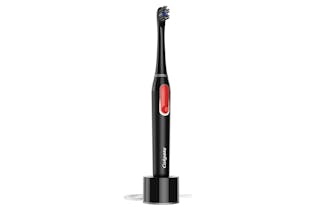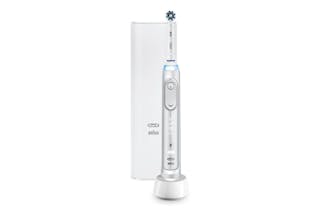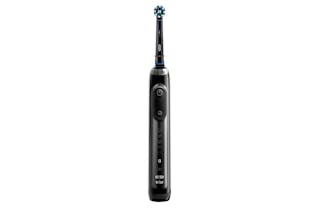Electric toothbrushes
Look after your teeth and gums with an electric toothbrush.
Brushing with an electric toothbrush can help you keep your teeth and gums clean and healthy. Which models can clean well and hold a charge?
Do you need one?
The main advantage of electric toothbrushes is they do the main brushing movements for you so you can concentrate on how and where to put the brush. They also have some useful features, such as timers, so you know you’ve cleaned your teeth for the recommended 2 minutes.
According to clinical trials you’re more likely to achieve good oral health with an electric toothbrush than a regular one. A Cochrane Review, updated in 2014, assessed 56 studies and concluded there was an 11% reduction in plaque at 1-to-3 months, and a 21% reduction after 3 months of using an electric toothbrush. There was also a reduction in gingivitis, which can lead to gum disease.
But there’s more to perfect pearlers than just going electric. According to New Zealand Dental Association senior oral health educator Dr Deepa Hughes brushing your teeth correctly twice a day, for 2 minutes, with fluoride toothpaste, is more important than the issue of using a manual versus electric toothbrush.
However, there are some situations where an electric toothbrush might make brushing easier.
- If you have limited dexterity – such as the physically disabled, or you have a medical condition like arthritis.
- If you have orthodontic appliances such as braces.
The novelty of an electric toothbrush can also motivate people who don’t regularly brush their teeth. The 2-minute timer is handy to ensure you brush for a full 2 minutes – it’s amazing how long a 2-minute clean feels! Some models also vibrate or pause every 30 seconds to tell you when it’s time to clean a different part of your mouth.
Others might be motivated to brush longer or correctly if they’ve spent money on an electric toothbrush.
Children should use a brush (manual or electric) that fits properly in their mouth, reaches their back teeth comfortably, and has soft bristles. Dr Hughes says that although an electric toothbrush can encourage children to clean their teeth, it isn’t a replacement for adult supervision – the most important thing for children is using the proper brushing technique.
Toothbrush types
Electric toothbrushes all have different brush actions that work in different ways.
- Rotating – have a set of bristles that spin. Bristles can be arranged in a circle that rotates, or individual tufts of bristles can spin.
- Oscillating – have small, round heads and the head oscillates (rotates in one direction, then the other) cleaning one tooth at a time to remove plaque.
- Pulsating – some rotating and rotating-oscillating toothbrushes pulsate to make the head move backwards and forwards against teeth while it’s spinning. This helps dislodge plaque.
- Sonic – vibrate at high speeds and frequency to help break down plaque.
Battery life
There’s a big difference in how long each brush takes to recharge.
The fastest brushes charge in less than 12 hours – so they’ll be fully charged between each brush if you keep your brush on the charger. But the slowest brush takes 24 hours to charge!
Our tests also found large differences in how long each battery stays charged. They ranged from 34 minutes (or the equivalent of 17 two-minute brushes) to 108 minutes (54 brushes).
If you plan to store your brush on the charger and keep the battery constantly topped up, it’s less important to choose a model with a long-lasting battery. But if you prefer to keep the charger packed away, or you want to take your brush away without the charger, battery life is more important.
Brush heads
Gone are the days of picking a soft, medium or hard brush head. Most Oral-B and Philips Sonicare toothbrushes can be used with a range of brush heads which are marketed as having a specific clean – such as whitening, flossing or sensitive. However, when we tested different brush heads on the same handle, we found there wasn’t much difference in how well they removed plaque. The only exception was when we tested sensitive brush heads. We weren’t surprised by this as sensitive heads have softer bristles, which are less abrasive on teeth.
You’ll need to replace the brush head once the bristles are worn – manufacturers recommend every 3 to 4 months. But replacements can be pricey so factor that in when you’re choosing a toothbrush. The brush heads we tested range in price from $9 to $19 per head.
| Toothbrush heads | Price/brush head ($) |
|---|---|
| Oral B 3D White (2-pack) | 10 |
| Oral B Cross Action (2-pack) | 10 |
| Oral B Precision Clean (2-pack) | 9 |
| Oral B Sensitive (2-pack) | 10 |
| Philips Sonicare Diamond Clean (3-pack) | 15 |
| Philips Sonicare Plaque Control (3-pack) | 13 |
| Philips Sonicare Premium Plaque (2-pack) | 19 |
| Philips Sonicare Premium White (2-pack) | 19 |
| Philips Sonicare Sensitive (3-pack) | 13 |
Features to consider
If you’re thinking about buying an electric toothbrush, keep these points in mind.
-
Charge indicator – alerts you when it’s time to recharge. Handy for travellers or if you regularly unplug your charger.
- Different settings – such as “sensitive”, “deep clean” or “whitening” make for a more versatile toothbrush. These settings change the pattern of brushing.
- Timer – helps you track your recommended two-minute clean. Some also beep, pause or vibrate after 30 seconds so you know when to move onto another area of your mouth. Others beep or vibrate when you have reached the recommended two-minute clean.
- Storage box or travel container – handy when you go away on holiday.
- Container or stand for extra heads – useful for families or couples who share the same toothbrush handle but have separate brush heads.
- Replaceable heads – you’ll need to replace the brush head once the bristles are worn – manufacturers recommend every three to four months. However, replacements can be pricey so factor that in when you’re choosing a toothbrush. The brush heads we tested ranged in price from $9 to $19 per head.
- Pressure sensor – this can prevent gum damage by detecting when you’re brushing too hard and reducing the movement action of the toothbrush.
- Smartphone compatibility – links to a smartphone app. Features include monitoring your brushing habits or timing how long you’re brushing your teeth.
Brushing tips
Whether you use a manual or an electric toothbrush, these tips will help you look after your teeth and gums.
- Brush twice daily for two minutes. The best technique is brushing at a 45° angle towards the gum line, moving the brush back and forth using small, gentle strokes. Make sure you clean all the surfaces (outer, inner and chewing surfaces) of your teeth.
- Brush heads should be replaced every three to four months, or earlier if the bristles wear out.
- Use fluoride toothpaste and spit it out after brushing. Avoid rinsing after brushing as this washes the fluoride away from your teeth.
- Floss or use interdental brushes once a day to clean between your teeth.
- Avoid sugary, sticky or acidic foods and drinks between meals.
- Visit your dentist for regular check-ups.
We've tested 23 electric toothbrushes.
Find the right one for you.


